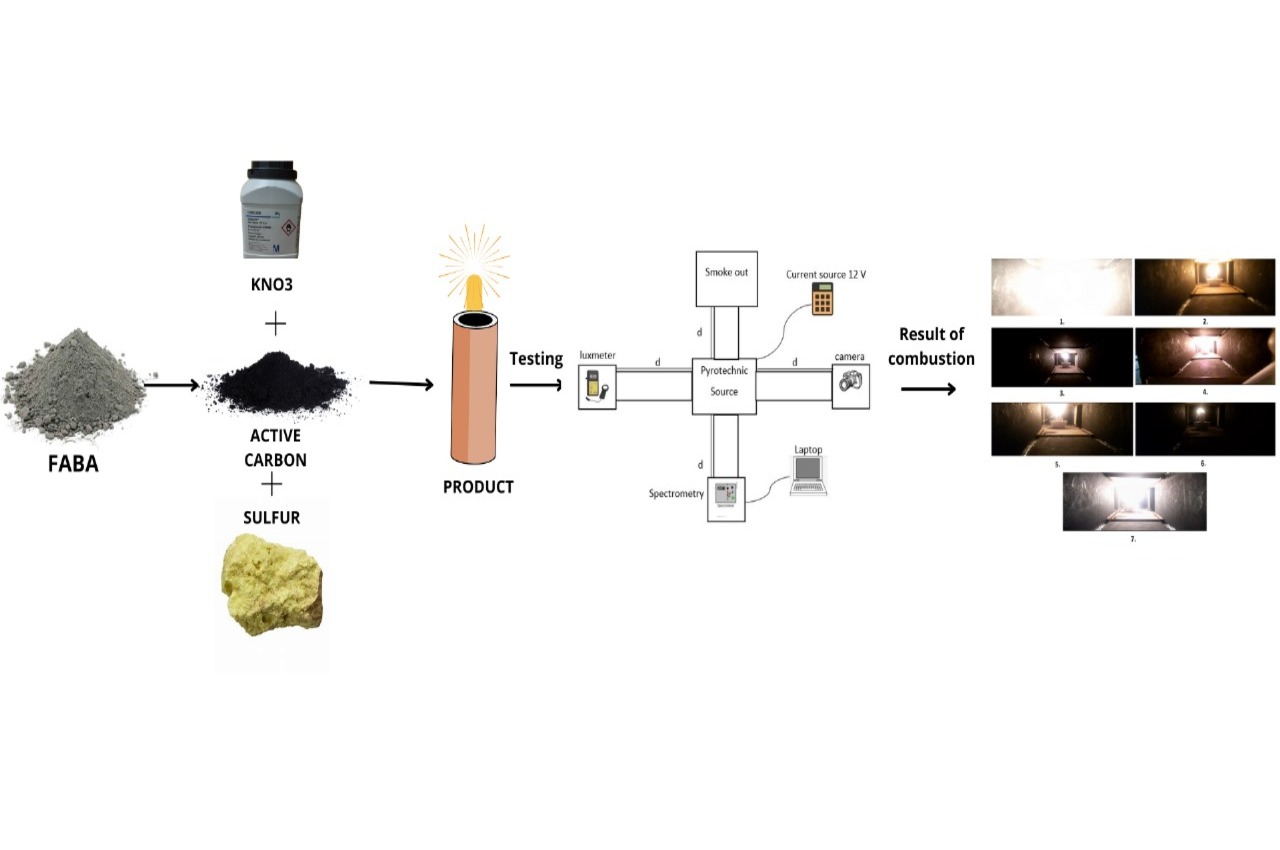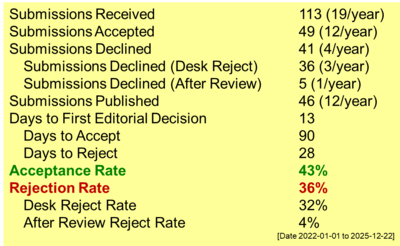Light Pyrotechnics Using Gunpowder Derived from Fly Ash Bottom Ash (FABA) Waste and Activated Carbon
DOI:
https://doi.org/10.55749/ijcs.v3i1.42Keywords:
Activated carbon, FABA, Gunpowder, Light intensity, Light pyrotechnicAbstract
Pyrotechnic materials are a category of materials that are often used in various applications, including military activities, lighting, signaling, and combat effects. In this study, an experiment was conducted to create a light pyrotechnic material using gunpowder, which is a mixture of potassium nitrate, sulfur, and activated carbon. The manufacturing process involved the activation of carbon from fly ash bottom ash (FABA) waste and the composition of different pyrotechnic materials. The experiment involved testing pyrotechnic compositions with varying ratios of KNO3 : carbon : sulfur. The results showed that the composition with a ratio of 15 : 7.5 : 7.5 produced the highest light intensity, reaching 104 lux, and provided optimal visual effects. In addition, the relative proportions of oxidizer, carbon and sulfur affected the type of pyrotechnic effect produced. Pyrotechnic light generation from gunpowder could be considered successful, and the best composition for spectacular visual effects was a ratio of 15 : 7.5 : 7.5. However, sufficient caution and knowledge were required in the use of pyrotechnic materials to ensure safety and compliance with applicable regulations.
References
Kanitkar, S., Haynes, D., Sabolsky, E. M., Chorpening, B. 2023. A review of colored light production by pyrotechnic materials. Propellants Explos. Pyrotech. 48(11). e202300012. doi: https://doi.org/10.1002/prep.202300012.
Kumar, N., Dixit, A., Kumar, N., & Dixit, A. 2019. Nanotechnology-driven explosives and propellants. In: Nanotechnology for Defence Applications pp 81-115. Springer, Cham. doi: https://doi.org/10.1007/978-3-030-29880-7_3.
Verbovytskyy, Y., & Harrison, R. 2022. Pyrotechnic strobe compositions: an overview. Propellants Explos. Pyrotech. 47(3). e202100311. doi: https://doi.org/10.1002/prep.202100311.
Lestariana, E. 2007. Black powder sebagai bahan isian igniter. Berita Dirgantara. 8(4). 100-112.
Sabatini, J.J., Nagori, A.V., Chen, G., Chu, P. 2012. High-nitrogen-based pyrotechnics: longer-and brighter-burning, perchlorate-free, red-light illuminants for military and civilian applications. Chem.-Eur. J. 18(2). 628-631. doi: https://doi.org/10.1002/chem.201102485.
Klapötke, T.M., & Rusan, M. 2023. Nitrogen-rich pyrotechnic materials for light and smoke. In: Nitrogen-Rich Energetic Materials pp. 397-414. Wiley-VCH GmbH. doi: https://doi.org/10.1002/9783527832644.ch11.
Anggara, F., Petrus, H., Besari, D.A.A., Manurung, H. 2021. Review on characterization and utilization potential of fly ash and bottom ash (FABA). Bul. Sumber Daya Geol. 16(1). 53–70. doi: https://doi.org/10.47599/bsdg.v16i1.320.
Fordham, S. 2013. High explosives and propellants. Elsevier.
Sivapirakasam, S.P., Soni, P., Surianarayanan, M., Balasubramanian, K.R. 2019. Thermal reaction studies and prediction of stoichiometry of pyrotechnic compositions using DSC and XRD methods. Thermochim. Acta. 675. 100-106. doi: https://doi.org/10.1016/j.tca.2019.03.009.
Junyi, W. 2019. Research on rapid semi-quantitative determination of sulfur in pyrotechnics. SWCAS 2019. doi: https://doi.org/10.25236/swcas.2019.009.
Lin, C.C. 2016. A review of the impact of fireworks on particulate matter in ambient air. J. Air Waste Manag. Assoc. 66(12). 1171-1182. doi: https://doi.org/10.1080/10962247.2016.1219280.
Piceros, E., Pérez, K., Jeldres, R.I., Robles, P., Gálvez, E., Reyes, G., Loeza, C., Villagrán, C., Toro, N. 2022. Obtaining the flame temperature from spectral emission of the combustion of copper concentrates. J. Mater. Res. Technol. 17. 937-947. doi: https://doi.org/10.1016/j.jmrt.2022.01.008.
Dong, W. S., Zhang, H., Tariq, Q. U. N., Li, Z., Zhang, C., Wu, X., Yu, Q., Li, Z.M., Zhou, Z.N., Zhang, J.G. 2023. Metal salts of 4-chloro-3,5-dinitropyrazole for promising eco-friendly primary colors pyrotechnics. Inorg. Chem. 62(36). 14559-14567. doi: https://doi.org/10.1021/acs.inorgchem.3c01602.
Ambekar, A., Kim, M., Yoh, J.J. 2017. Characterization of display pyrotechnic propellants: Colored light. Appl. Therm. Eng. 110. 1066-1074. doi: https://doi.org/10.1016/j.applthermaleng.2016.09.040.
Steinhauser, G., & Klapötke, T.M. 2008. “Green” pyrotechnics: a chemists' challenge. Angew. Chem. Int. Ed. 47(18). 3330-3347. doi: https://doi.org/10.1002/anie.200704510.
Jang, H.Y., & Hwang, C.H. 2023. Preliminary study for smoke color classification of combustibles using the distribution of light scattering by smoke particles. Appl. Sci. 13(1). 669. doi: https://doi.org/10.3390/app13010669.
Singh, D., Tassew, D.D., Nelson, J., Chalbot, M.C.G., Kavouras, I.G., Tesfaigzi, Y., & Demokritou, P. 2023. Physicochemical and toxicological properties of wood smoke particulate matter as a function of wood species and combustion condition. J. Hazard. Mater. 441. 129874. doi: https://doi.org/10.1016/j.jhazmat.2022.129874

Downloads
Published
How to Cite
Issue
Section
License
Copyright (c) 2024 Indonesian Journal of Chemical Studies

This work is licensed under a Creative Commons Attribution-ShareAlike 4.0 International License.






















